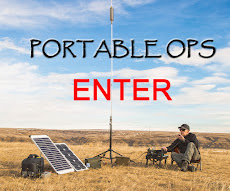Friday, January 01, 2016
DXpedition On The Ice
Note....all photos expand
This photo finds me south of Canmore AB in the Spray Valley where I had arrived via the Smith Dorrion highway from the Kananaskis Valley earlier in the morning. After loading my sleigh with everything I needed including the makings for tea and a few snacks in case the growly's set in, I made my way out onto the lake to where I set up my portable HF station on Spray Lakes Reservoir as seen in the above photo.
 I also was doing some ice-fishing as you can tell by my fishing rod set up over a hole that I had drilled through the ice with my ice auger.
I also was doing some ice-fishing as you can tell by my fishing rod set up over a hole that I had drilled through the ice with my ice auger.
At one time Spray Lakes were a string of lakes formed along the Spray River, a tributary of the Bow River that has its beginnings and flows through Banff Park located just a few miles west of the Spray Valley. With the damming of the river, the lakes were united in the Spray Lakes Reservoir that is 15 kilometers in length, and is popular with ice fisherman throughout the winter months, not to mention the cross-country skiers and the various companies running dog-sled operations on the trails bordering the lake.
In case your wondering how thick the ice is at this time of the year, I had to auger through approximately 16" of ice before breaking through the ice and in to water.
While waiting for the fish to bite, I was running more tests with my new antenna that continues to impress me with how well its performs on the various bands that I worked while out on the ice.
 The antenna was a snap to set up, and the secret to allowing this to happen, was with the use of my cordless drill visible in the photo. With a 1/2" sheet-metal drill-bit installed in the chuck, I drilled a hole approximately 4" deep in the ice for the spike of the coaxial junction box to be inserted in.
The antenna was a snap to set up, and the secret to allowing this to happen, was with the use of my cordless drill visible in the photo. With a 1/2" sheet-metal drill-bit installed in the chuck, I drilled a hole approximately 4" deep in the ice for the spike of the coaxial junction box to be inserted in.
The beauty of this arrangement is the fact that the antenna can be assembled lying on the ice, and then by lifting it up to a vertical position, and dropping it in the hole that I had drilled, I was able to let go of the mast as the antenna now stood on its own.
In actuality there was no need for the Dacron guy-lines on this day, as there was no wind, but I installed them regardless, to allow me to check out how well my guy-line would work out by drilling the additional holes for the high-tensile aluminum anchors.
Once the anchors were in inserted in the holes drilled at approximately 30 degrees, it was just a matter of using the line-adjusters to tighten each of the guy-lines.
I have other antennas in my antenna arsenal that I have built in the past that I could have used, but they need extras like my push-up mast, and that was not an option, as I wanted an antenna that would not need any need of push-up masts, tripods, and other supports, as I wanted the system I had in mind to be very portable, and today my latest antenna creation as proved to be the antenna required for operations such as this one.
I recently acquired the Yaesu FT-897D with the optional internal batteries, and my original plan for this transceiver was for it to be operated in the outdoors from wherever the location may be.
 Now it goes without saying that keeping the transceiver (and the antenna) out of harms way while transporting them was a priority.
Now it goes without saying that keeping the transceiver (and the antenna) out of harms way while transporting them was a priority.
The case that the FT-897D resides in, and in the various photos shot on the ice, I actually found at Cabela's here in Calgary. The case is similar to a Pelican case, although this particular case from Cabela's was meant to store handguns in, but my tape-measure told me that my FT-897D would fit in it just fine, and the cost was half of a Pelican case of similar size.
Now having said that, it is not a Pelican case, but the build impressed me enough to trust it with my FT-897D stored within.
 The case that my 10-40 meter portable antenna resides in, I found at Princess Auto in the surplus department, and it was meant to store archery arrows in, but worked out perfectly with a few modifications for the job at hand of keeping my antenna safely stored within.
The case that my 10-40 meter portable antenna resides in, I found at Princess Auto in the surplus department, and it was meant to store archery arrows in, but worked out perfectly with a few modifications for the job at hand of keeping my antenna safely stored within.
On this day with the temperature sitting at -17 Celsius, it was important to keep them out of the elements.
 I also was pleased to find that my Yaesu FT-897D performed well while out in the cold, as the temperature was hovering in the -17 Celsius range, and after 3 hours operating on the A battery, the voltage was still reading above 12 volts on the meter of the 897, and I never did have to switch to the B battery.
I also was pleased to find that my Yaesu FT-897D performed well while out in the cold, as the temperature was hovering in the -17 Celsius range, and after 3 hours operating on the A battery, the voltage was still reading above 12 volts on the meter of the 897, and I never did have to switch to the B battery.
I made a number of contacts on 40 meters, including checking in on the Noon Time Net, a public service Amateur Radio net that serves the western US as well as AB and BC, and meets every day on 7268.5 kHz.
 When it came time to pack up and head back to my mobile parked on the Smith Dorian Highway approximately a 1/2 kilometer away, I would have liked to stay longer, but with the sun dropping beneath the mountains on the west side of the valley and with the shadows getting long, it was time to go.
When it came time to pack up and head back to my mobile parked on the Smith Dorian Highway approximately a 1/2 kilometer away, I would have liked to stay longer, but with the sun dropping beneath the mountains on the west side of the valley and with the shadows getting long, it was time to go.
Still as I worked my way back to the shoreline and my mobile, I was already planning my next trip out to the ice of a lake located in southern Alberta.
Lets see now, maybe next week I could go down to Travers reservoir, or there is that overnight camping trip I have in mind for Dinosaur, or maybe......
Note....all photos expand.
Check out my website
www.jerryclement.ca
This photo finds me south of Canmore AB in the Spray Valley where I had arrived via the Smith Dorrion highway from the Kananaskis Valley earlier in the morning. After loading my sleigh with everything I needed including the makings for tea and a few snacks in case the growly's set in, I made my way out onto the lake to where I set up my portable HF station on Spray Lakes Reservoir as seen in the above photo.
 I also was doing some ice-fishing as you can tell by my fishing rod set up over a hole that I had drilled through the ice with my ice auger.
I also was doing some ice-fishing as you can tell by my fishing rod set up over a hole that I had drilled through the ice with my ice auger. At one time Spray Lakes were a string of lakes formed along the Spray River, a tributary of the Bow River that has its beginnings and flows through Banff Park located just a few miles west of the Spray Valley. With the damming of the river, the lakes were united in the Spray Lakes Reservoir that is 15 kilometers in length, and is popular with ice fisherman throughout the winter months, not to mention the cross-country skiers and the various companies running dog-sled operations on the trails bordering the lake.
In case your wondering how thick the ice is at this time of the year, I had to auger through approximately 16" of ice before breaking through the ice and in to water.
While waiting for the fish to bite, I was running more tests with my new antenna that continues to impress me with how well its performs on the various bands that I worked while out on the ice.
 The antenna was a snap to set up, and the secret to allowing this to happen, was with the use of my cordless drill visible in the photo. With a 1/2" sheet-metal drill-bit installed in the chuck, I drilled a hole approximately 4" deep in the ice for the spike of the coaxial junction box to be inserted in.
The antenna was a snap to set up, and the secret to allowing this to happen, was with the use of my cordless drill visible in the photo. With a 1/2" sheet-metal drill-bit installed in the chuck, I drilled a hole approximately 4" deep in the ice for the spike of the coaxial junction box to be inserted in.The beauty of this arrangement is the fact that the antenna can be assembled lying on the ice, and then by lifting it up to a vertical position, and dropping it in the hole that I had drilled, I was able to let go of the mast as the antenna now stood on its own.
In actuality there was no need for the Dacron guy-lines on this day, as there was no wind, but I installed them regardless, to allow me to check out how well my guy-line would work out by drilling the additional holes for the high-tensile aluminum anchors.
Once the anchors were in inserted in the holes drilled at approximately 30 degrees, it was just a matter of using the line-adjusters to tighten each of the guy-lines.
I have other antennas in my antenna arsenal that I have built in the past that I could have used, but they need extras like my push-up mast, and that was not an option, as I wanted an antenna that would not need any need of push-up masts, tripods, and other supports, as I wanted the system I had in mind to be very portable, and today my latest antenna creation as proved to be the antenna required for operations such as this one.
I recently acquired the Yaesu FT-897D with the optional internal batteries, and my original plan for this transceiver was for it to be operated in the outdoors from wherever the location may be.
 Now it goes without saying that keeping the transceiver (and the antenna) out of harms way while transporting them was a priority.
Now it goes without saying that keeping the transceiver (and the antenna) out of harms way while transporting them was a priority.The case that the FT-897D resides in, and in the various photos shot on the ice, I actually found at Cabela's here in Calgary. The case is similar to a Pelican case, although this particular case from Cabela's was meant to store handguns in, but my tape-measure told me that my FT-897D would fit in it just fine, and the cost was half of a Pelican case of similar size.
Now having said that, it is not a Pelican case, but the build impressed me enough to trust it with my FT-897D stored within.
 The case that my 10-40 meter portable antenna resides in, I found at Princess Auto in the surplus department, and it was meant to store archery arrows in, but worked out perfectly with a few modifications for the job at hand of keeping my antenna safely stored within.
The case that my 10-40 meter portable antenna resides in, I found at Princess Auto in the surplus department, and it was meant to store archery arrows in, but worked out perfectly with a few modifications for the job at hand of keeping my antenna safely stored within.On this day with the temperature sitting at -17 Celsius, it was important to keep them out of the elements.
 I also was pleased to find that my Yaesu FT-897D performed well while out in the cold, as the temperature was hovering in the -17 Celsius range, and after 3 hours operating on the A battery, the voltage was still reading above 12 volts on the meter of the 897, and I never did have to switch to the B battery.
I also was pleased to find that my Yaesu FT-897D performed well while out in the cold, as the temperature was hovering in the -17 Celsius range, and after 3 hours operating on the A battery, the voltage was still reading above 12 volts on the meter of the 897, and I never did have to switch to the B battery.I made a number of contacts on 40 meters, including checking in on the Noon Time Net, a public service Amateur Radio net that serves the western US as well as AB and BC, and meets every day on 7268.5 kHz.
 When it came time to pack up and head back to my mobile parked on the Smith Dorian Highway approximately a 1/2 kilometer away, I would have liked to stay longer, but with the sun dropping beneath the mountains on the west side of the valley and with the shadows getting long, it was time to go.
When it came time to pack up and head back to my mobile parked on the Smith Dorian Highway approximately a 1/2 kilometer away, I would have liked to stay longer, but with the sun dropping beneath the mountains on the west side of the valley and with the shadows getting long, it was time to go.Still as I worked my way back to the shoreline and my mobile, I was already planning my next trip out to the ice of a lake located in southern Alberta.
Lets see now, maybe next week I could go down to Travers reservoir, or there is that overnight camping trip I have in mind for Dinosaur, or maybe......
Note....all photos expand.
Check out my website
www.jerryclement.ca



















No comments yet